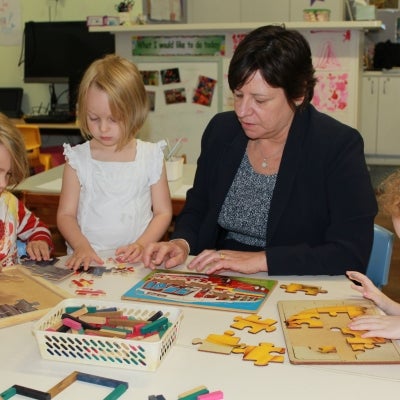Refine results
-
14 December 2012Book page
Commission Website: National Inquiry into Children in Immigration Detention
The Equal Opportunity Commission of Victoria (the Commission) commends the enquiry by the Human Rights and Equal Opportunity Commission into the circumstances of children in immigration detention and the longer-term effects of detention on children who have entered the Australian community. This submission considers the post-detention experience and treatment of children and young adults released… -
Children's Rights15 March 2018Media Release
Reappointment of National Children’s Commissioner
The Australian Human Rights Commission welcomes the reappointment of National Children’s Commissioner Megan Mitchell. Emeritus Professor Rosalind Croucher, President of the Australian Human Rights Commission, said Commissioner Mitchell would continue strengthening protections for children’s rights in Australia. “This is a marvellous opportunity for Megan to consolidate five years of… -
Employers18 February 2015Quick Guide
Harassment
Harassment can be against the law when a person is treated less favourably on the basis of certain personal characteristics, such as race, sex, pregnancy, marital status, breastfeeding, age, disability, sexual orientation, gender identity or intersex status. Some limited exemptions and exceptions apply. Harassment can include behaviour such as: telling insulting jokes about particular racial… -
Race Discrimination20 October 2017Webpage

Race Discrimination Guides
Guides and advice by the Australian Human Rights Commission The Commission may issue guidance and advice to assist persons and organisations with responsibilities under the legislation to avoid discrimination and meet their responsibilities. This guidance or advice is not legally binding regulation. Guides Race Hate and the Racial Discrimination Act (2016) At a glance: Racial vilification… -
Legal14 December 2012Webpage
Submission: Human Rights and Good Governance Education
The Human Rights and Equal Opportunity Commission (HREOC) which was established in 1986 by the Federal Parliament as successor to the 1981 Human Rights Commission is an independent statutory authority whose functions are to monitor, protect and promote human rights in Australia. The Commission has played a key role in the education of civil society in regard to these rights. -
14 December 2012Book page
Native Title Report 2002: Extinguishment of Native Title
The two recent High Court decisions in Miriuwung Gajerrong [1] and Wilson v Anderson [2] have clarified some important issues regarding the extinguishment of native title under the Native Title Act 1993 (Cwlth) (‘NTA’) and its relationship with extinguishment under the common law. They also provide some important insights into the meaning of discrimination as it responds… -
14 December 2012Book page
Native Title Report 2000: Chapter 4: Indigenous heritage
The recognition of native title by the High Court in 1992 was a significant development in the legal apparatus for protecting Indigenous culture. Under the concept of native title it is possible that sacred and significant sites and objects might be protected, not within the historical category of Aboriginal heritage, but as matters valued in contemporary Indigenous culture with current… -
28 October 2013Book page
2 Onshore detention and processing
2.1 Mandatory immigration detention It is mandatory under the Migration Act for every non-citizen who is in Australia without a valid visa to be detained, regardless of his or her individual circumstances. [24] Once detained, unlawful non-citizens must remain in detention until they are either granted a visa or removed from Australia. [25] The majority of unlawful non-citizens are detained… -
14 December 2012Book page
20 Years on: The Challenges Continue - Chapter 2
This chapter provides an overview of some of the main findings of the national telephone survey on the incidence and nature of sexual harassment. Section 2.2 discusses the incidence rate of the experience of sexual harassment in the community generally, and more particularly the incidence rate of sexual harassment in the workplace experienced in the five years prior to conducting the survey… -
Commission – General14 December 2012Speech
President speech: Human rights, the Constitution and a Human Rights Act
We are gathered this evening on the land of the Ngambri people, from whom Canberra takes its name, and I pay my respects to their elders past and present. -
Commission – General14 December 2012Speech
President speech: The National Human Rights Consultation: Outcomes
I would like to begin by acknowledging the traditional owners of the land on which we meet, the Wurundjeri People of the Kulin Nation, and pay my respects to their elders past and present. -
Rights and Freedoms14 December 2012Speech
"Human Rights in Contemporary Australia": Dr Sev Ozdowski (2001)
Speech by Dr Sev Ozdowski at the United Nations Association of Australia - Tasmanian Branch - Human Rights Seminar: Human Rights from the Perspective of Individual, Collective and Corporate Responsibilities, Saturday 17 November 2001 -
Disability Rights14 December 2012Speech
Human rights for people with intellectual disabilities in Australia: where to from here?
I will not speak in detail about human rights conventions and disability because this topic is addressed by my co-speaker in this session, Karl Lachwitz. I will say though that international human rights law and human rights debate has not yet acknowledged adequately or sufficiently clearly that people with a disability are part of what the "human" in human rights means. Equally, there… -
LGBTIQ+13 July 2018Webpage

Background and terminology
Protecting the human rights of people born with variations in sex characteristics in the context of medical interventions Background In Australian, some people born with variations in sex characteristics may be subject to medical interventions without themselves providing informed consent. It has been reported that this may be done where there is no medical need - for example, it may take… -
Aboriginal and Torres Strait Islander Social Justice26 February 2018Media Release
Close the Gap Campaign welcomes extension of the Tackling Indigenous Smoking programs
The Close the Gap Campaign welcomes the new investment in the successful ‘National Tackling Indigenous Smoking’ (TIS) programs. The Federal Minister for Indigenous Health Ken Wyatt announced the Federal Government will provide a further $183.7 million to TIS over four years across its current 37 regional Aboriginal and Torres Strait Islander TIS health providers. The Campaign’s recently… -
14 April 2015Book page
1 Social justice - Year in review
1.1 Introduction 1.2 Machinery of Government changes 1.3 The 2014 Budget 1.4 Leadership, representation and engagement 1.5 Constitutional recognition 1.6 Indigenous Jobs and Training Review 1.7 Closing the Gap 1.8 Stolen Generations 1.9 International developments 1.10 Australian Human Rights Commission complaints 1.11 Conclusion 1.1 Introduction At the beginning of this reporting period, we… -
29 January 2015Book page
1 Introduction
1.1 A snapshot of children in detention 1.2 Australian law and the detention of children 1.3 Does the Government owe a duty of care to children in detention? 1.4 International law and the detention of children My hope finished now. I don’t have any hope. I feel I will die in detention. (Unaccompanied 17 year old, Phosphate Hill Detention Centre, Christmas Island, 4 March 2014) Drawing by… -
Legal14 December 2012Webpage
Exemptions
The Commission is able to grant temporary exemptions from some parts of the Sex Discrimination Act, the Disability Discrimination Act and the Age Discrimination Act. -
Aboriginal and Torres Strait Islander Social Justice14 December 2012Webpage
Reparations for the stolen generations - Government responds - Senator Aden Ridgeway
Acknowledgement of guests from overseas, Parliamentary colleagues, Social Justice Commissioner Mr Bill Jonas, Justice Elizabeth Evatt, ATSIC Commissioners, distinguished guests. -
14 December 2012Book page
Social Justice Report 2003: Chapter 5: Addressing family violence in Indigenous communities
back to contents Chapter 5: Addressing family violence in Indigenous communities There is no issue currently causing more destruction to the fabric of Indigenous communities than family violence. This has been acknowledged by all levels of government in recent years, with a number of significant inquiries and initiatives undertaken or commenced at the federal, state and territory level to address…
